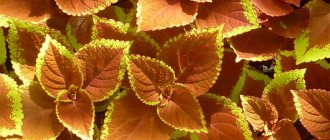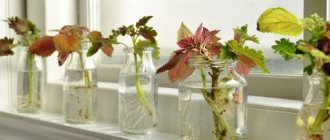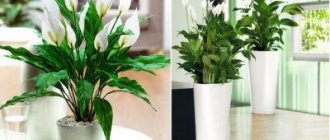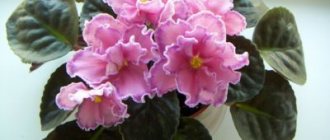Coleus as a crop has been developing relatively recently; in the 19th century, its seeds were brought to Europe from Indonesia, and it came to Russia much later. Today, its popularity is gaining momentum in the flowerbeds of many gardeners as an annual plant. Despite the fact that shrubs are grown in gardens, flower beds and balconies, it can also be an indoor perennial shrub.
This article is dedicated to the amazing “Kleos”, which translated from ancient Greek sounds like “Case”. This name was formed due to the structure of the stamen filaments, which visually form something like a case. The article touches on all the subtleties about Coleus: reproduction, cultivation, care, features and even beneficial properties when used in folk medicine.
Description of the flower
Coleus is also known as Coleus, but amateur gardeners periodically come up with other different names for it. Some call it “Nettle” because of the external similarity of the leaves; they are as pointed as those of nettles, while others, for its simplicity and unpretentiousness, give it the name “Corton for the poor.”
Visually, the bush is represented by many stems that are woody at the base; they are very strong and have a clear texture. The vertically growing stems of the bush are covered with brightly colored leaves, which depend on the varieties of the genus and variety. All varieties have different colors, perhaps no plant can compete with Coleus in the versatility of color shades. In its varieties, the only thing missing is probably blue; there are many other colors.
Over time, it becomes lush and voluminous; the vegetation quickly grows and fills all the free space in the flowerbed, creating a beautiful flower meadow. At home, it does not grow more than 1 meter, which cannot be said about those grown in warm southern countries.
Coleus – photo
It is simply impossible to go through all the varieties and shades of coleus at one time. But we did our best and prepared a photo selection to show you its versatility!
Photo: botanichka.ru
Photo: oir.mobi
Photo: trizio.ru
Photo: krsk.au.ru
Photo: setafi.com
Photo: shawnacoronado.com
Photo: rastenievod-007.blogspot.com
Photo: artfile.ru Photo: sady-msk.ru
Photo: sytycd.ru
Photo: kashalot.com Photo: domashniecvety.ru
Photo: botanichka.ru
Photo: saddrakona.ru Photo: zen.yandex.ru
Photo: plantasonya.com.br
Photo: sady-msk.ru Photo: telemetr.me
Photo: solo-semena.ru
Photo: plantorama.ru
Photo: greengarden34.ru
Photo: pinterest.ru
Photo: gardennews.ru
Photo: ecologia.chernbib.ru
Photo: pinterest.ru
Photo: greenlab-shop.ru
Did you like the post? Subscribe to our channel in Yandex.Zen, it really helps us in our development!
Peculiarities
Coleus occupies a special place among ornamental crops, as it has multifaceted and very multi-colored foliage, rich in chic color. In addition to traditional green, there are red, burgundy, yellow, purple and other colors. They are very bright and colorful, and may have edges around the edges or stripes and spots in the middle. Thanks to the color shades, which are very eye-catching, it is possible at first glance to distinguish the bush from neighboring flowers in the flowerbed. In nature, there are more than 150 species and varieties of plants that are created by nature or introduced in a hybrid way.
The universal purpose adds features for growing this crop. They are grown with equal success both indoors and in the landscape. The rich colors of the crop go well with club flower beds and adequately emphasize the garden design.
Peduncles can appear from March to late autumn, and in indoor conditions even in winter. The inflorescence has small spike-shaped flowers, most often blue or light blue, they are not very attractive and do not carry any benefits.
Characteristics and origin of the plant
Coleus comes from the hot tropics of Africa and Asia, where it grows as a perennial and captivates with its decorative foliage. In its arsenal there are about 150 varieties, distinguishable from each other and used in landscape design of gardens and home floriculture.
Coleus is popularly called “nettle,” which explains its appearance. The leaves of the plant are similar to the familiar nettle, but they do not sting and are more attractive. The main asset of the flower is the color of the leaf blades - variegated, bright, flashy, with multiple patterns and shades.
The height of the bush reaches 80 cm, the stem is powerful, becoming woody with age. The leaves are opposite on short petioles and may differ in shape depending on the variety. The flowers are collected in a spike and resemble sage - small, blue buds. Unusual colors give the plant charm and sophistication; it is often used in borders, mixborders, borders and to create fantasy compositions.
Landing
Proper planting plays an important role for the growth and development of the bush in the future.
Since Coleus is a very heat-loving flower, it is planted in the warm season in well-moistened soil. For drainage, place a layer of expanded clay on the bottom of the pot. The roots are placed in the soil so that they are well covered with it; the growing point is not covered.
After planting, you should not expose the pot to the sun; to adapt the root system, you need to spend some time in a shaded place.
Planting methods
Landing is carried out in only 2 ways:
- Planting with seeds.
- By cuttings.
Getting a lush designer bush is a matter of time. You just need to trim and pinch it in a timely manner, giving it shape, and use the cuttings for propagation.
Timing
The popularity of the plant lies in its unpretentiousness; it is completely undemanding in care. Any amateur gardener, even a beginner, can easily grow it.
Coleus cultivation is recommended in the spring, so that the bush begins to grow and delights with its abundance and splendor in the summer, in June. If grown from seeds, it is better to sow them in March in special plastic or wooden seedling boxes. But sowing seeds directly in open ground, as well as planting seedlings, is best done by the end of May, when cold weather is no longer expected.
Do not forget that this crop is very heat-loving; any low temperatures reaching below +8 degrees lead to inhibition of development and wilting of the bush.
Soil selection
Any fertile soil is suitable for planting and growing; ideally, for abundant and beautiful growth, the soil should be sufficiently mineralized and fertilized.
You should not plant a flower in an open, unprotected area exposed to wind. The shoots of the plant will stretch, and having reached a height, they will begin to fall and break under the influence of the wind. This will spoil the bush and give the flowerbed a discreet, unkempt look.
Possible diseases and pests, ways to get rid of them
Photos of coleus in a flowerbed show it as a plant that is practically never damaged by pests or garden infections. The appearance of the flower can be negatively affected by improper care and failure to comply with certain growing conditions.
Reasons for inhibited growth of Coleus and their consequences:
| Dense soil | Provokes stagnation of water and rotting of roots. The flower becomes sluggish and loses color. |
| Overwatering | When the flowerbed becomes swampy, the plant begins to shed its leaves. With prolonged excessive watering, the roots dry out. |
| Soil drying out | The leaves turn yellow and fall off. Prolonged drought without watering quickly leads to the death of the roots. |
| Lack of lighting | The color of the leaves becomes paler than stated by the variety; on variegated varieties it can become monochromatic. The shoots become thinner and overly elongated. |
| Too hot sun rays | Yellowish spots appear on succulent leaves, then the leaves dry out and fall off. |
Coleus weakened by improper maintenance can be attacked by insects.
Pests most often found on ornamental bushes:
- whitefly;
- spider mite;
- mealybug;
- aphid.
When insects are found in a flower bed, insecticides are used (Aktara, Aktellik), and for ticks - specialized acaricides (Oberon, Akarin).
When domestic Coleus are affected, they try to correct the situation by washing the bush with soapy water and regulating care. If such methods do not produce results, it is advisable to take the plants for chemical treatment to the balcony or open air.
Home care rules
Coleus does not require complicated care at home. In warm room temperatures it may be grown as a perennial flower in pots and planters. Flowering continues in the fall, growth activity continues in the spring, and dormancy occurs in the winter, cold period.
Growing at home does not give the gardener much trouble, but like any vegetation, for beautiful growth, it needs systematic care.
Lighting
It is photophilous and needs a sufficient amount of lighting; you should choose a fairly suitable place for it, but not under intense sunlight.
With excessive exposure to the sun, the bush loses its brightness and slows down its growth.
If there is not enough light, the bush begins to stretch and simultaneously shed its leaves, which leads to an unpresentable appearance.
Air humidity
Garden crops from warm countries simply need moisture and are completely intolerant of drought. If you organize regular watering of the soil and periodically moisten the leaves by spraying from a polyvilizer, then the shrub will not remain indifferent and will definitely reward you with the beautiful, rich and noble color of the leaves.
Temperature
Favorable temperature for growth is from 19 to 24 degrees.
The bush treats temperature changes normally, unless of course they reach strong jumps and cold air flow, including drafts.
Crown formation
To form a compact crown, the bushes are pruned several times a season. To grow carpet, cut to a height of 15 cm.
Watering rules
It loves moist soil and grows and develops comfortably in it.
Watering the vegetation in the pots is carried out directly into the ground at the moment when the top layer dries. It is also necessary to moisten the leaves abundantly.
Growing and care
Coleus comes from regions with a warm climate, so in our country it can be grown as a potted flower all year round or seasonally on balconies or in the garden, but it must be dug up or cuttings before frost to preserve it.
In our climate zone, coleus decorates apartment interiors most of the year and grows well in well-lit areas. However, if we want the plant to form beautifully, it is better to place it on the balcony or in the garden in the summer.
Coleus can also be grown in open ground; its seeds will themselves be sown into the substrate, causing the plant to spread.
As a potted flower, coleus ages quickly and needs to be refreshed frequently to maintain its beautiful appearance. It works great as a balcony plant, especially in colorful combinations where different varieties grow side by side to create beautiful compositions. As a garden plant, coleus grows quickly and is no less decorative than other species.
Coleus grows quickly, can bloom just as quickly, does not require large doses of fertilizer, and loves water.
Growing conditions
Coleus loves warmth, light and regular spraying of the leaves. The optimal temperature during the growing season is at least 16-18 °C.
The colors of coleus leaves are rich and extremely rich, but only when we provide them with plenty of light. At the same time, the plant maintains compact growth (clusters well), which can be further stimulated by removing the tops of the shoots.
In the shade or with insufficient sunny days, which is especially noticeable in the winter months, the shoots stretch, the colors fade, the leaves of even the brightest varieties become green, and they are often difficult to distinguish from each other.
However, not all varieties like direct, harsh sun (it can burn the leaves). Even varieties from the Kong group have appeared that are adapted to grow in full shade.
When planting and growing coleus at home, it is better to turn the pot every day, for example, a quarter in one direction, so that it looks attractive from all sides. In terms of access to the sun, full light in the morning and late afternoon is best. Around noon, especially in summer, the leaves should be protected from scorching.
Watering, fertilizing
Coleus is demanding of moisture and loves fertilizers. The plant will repay our efforts with interest; all summer it will grow intensively, striking with neon colors. It needs regular watering, the substrate must be constantly moist. But the plant does not tolerate overwatering - this quickly causes rotting of the roots.
Coleus are sensitive to calcium compounds found in tap water, and when too much of these substances are deposited in the soil, they lose leaves more rapidly. You can limit the leaf fall of coleus plants by watering them with boiled water. When boiling water, calcium compounds precipitate in the form of limescale on the walls of the kettle, and the boiled water becomes softer.
Coleus, especially those growing in the ground, do not require frequent fertilization. Indoor coleus in pots is fed every 2 weeks, from April to August, using liquid fertilizer for plants with decorative leaves.
Excess fertilizer can lead to brittle leaves, which has a negative effect, especially on large-leaved varieties. Sometimes heavy rain is enough to cause holes in coleus leaves.
Systematic removal of flowers
If in flowering ornamental plants we make sure that there are as many flowers as possible, then in the case of coleus, as soon as the summer season begins, we begin an endless “struggle” with flower buds. The procedure is systematically carried out until autumn - they need to be removed so that the plant is strong and beautiful!
Coleus flowers are usually white or bluish-white, small, and collected in clusters. They grow on the tops of the main shoots and from the axils of the leaves. The blossoms are truly beautiful, but the plant requires so much energy to produce them that if we let them bloom, the coleus will lose its beautiful leaves and become weaker overall. Therefore, it is better to remove the flowers, as they greatly weaken the plant. After removing the flowers, the plant bushes better.
Trimming and shaping
Coleus can be grown not only as a bush, but also as a tree. Continuous pinching of the lower leaves and shoots is required. Only the top ones are left until they form a crown and the main shoot becomes woody.
When our coleus is at the desired height, we cut off the side branches and leaves, leaving 4 young shoots at the very top. We also shorten the top. The plant will look unattractive for a while, but will soon begin to thicken.
After some time, trim the side shoots again, leaving about 4-5 nodes, and repeat this operation as the plant grows, giving the tree a spherical shape. Only varieties with lush growth and easy thickening are suitable for forming into a tree shape.
Autumn care, transplanting into pots, autumn pruning
As the temperature drops, you need to move the plant to a safe place. Temperatures below 10 degrees C will cause leaves to fade, become dull and, as a result, wither and die. When growing coleus, it is important to properly winterize it so that next season it can continue to play the role of an exotic star among garden plants.
The main problem is to provide the plant with the correct temperature. A better location is where environmental conditions can be constantly monitored, adapting them to the requirements of the plant.
Coleus do not tolerate wintering well in warm, dry apartments. In warm weather, they lose leaves, dry out, and are more often attacked by pests.
The best place is a greenhouse, conservatory or glassed-in balcony. When temperatures begin to drop in the fall, be sure to dig the coleus out of the ground and place it in a safe environment. Don't wait too long, temperatures below 8 degrees C will kill the coleus.
Autumn is a good time to prune coleus so that it grows proportionally and acquires a compact, neat shape. Shortening the above-ground part of the plant to half its height, done before digging it out of the ground, will reduce stress and help better tolerate replanting.
The size of the containers is chosen according to the size of the plants and especially their roots. The pots are filled with a well-drained substrate consisting of peat and garden soil. Plants need to be adapted to environmental changes gradually; before placing them permanently indoors, they need to be hardened for a week to new conditions.
Wintering
For wintering coleus, choose a place where the temperature will prevail at about 15 degrees C and good lighting conditions. A bright position with plenty of sunlight is optimal for plant development; a lack of light will lead to smaller leaves and poor color. The light source can be exposure to a well-lit sunny window or artificial lighting under an electric lamp.
Loss of leaf color, falling and wilting of some leaves are natural processes during the long winter months.
Coleus does not die, it simply lies dormant and recuperates before the next season. When spring comes, you will see that it comes to life, the leaves will begin to grow. Until then, it is better to provide it with suitable, stable conditions and place it in a greenhouse or other premises with optimal temperature and light conditions.
Diseases and pests
Coleus Blume rarely gets sick. The reason for the poor condition of the plant is most often excessive watering or lack of it. With high humidity and little air movement, gray mold may appear. To combat this disease, it is worth using the fungicide Topsin M 500SC.
In winter, especially when stored indoors, coleus can be attacked by whiteflies, aphids, and spider mites. These pests can be eliminated using the natural product Emulpar 940ec or Mospilan 20sp insecticide.
Coleus propagation
Reproduction of Coleus is not difficult, so gardeners, to grow it in the garden, simply dig up 1-2 bushes and move them indoors for the winter, so that they can be planted in flower beds again next year.
The root system of the plant is dense and dense, it easily takes root in a new place.
Propagation by seeds
Propagation by seeds is carried out in the spring. Sow the seeds in flower boxes with prepared, fertilized soil and cover with polyethylene or glass. Further care consists of systematic watering and ventilation.
Seed germination is almost 100%, occurring 10-15 days after sowing.
Cuttings
Cuttings are carried out from the tops of old shoots. Place the cuts in water until roots appear on the stems. After the root system has grown, the sprout can be planted in the ground, in a separate cup, or directly in a small pot.
Seedling
Since Koleus is rich in a powerful, dense root system, each sprout is grown in separate cups for ease of replanting. As soon as the shoots reach a height of 15-20 cm, they can be moved into open ground, into a separate hole. The distance between the holes should be about 30 cm.
Range of species
Tropical nettle is grown as an annual in open ground and as a perennial crop in pots. Decorative foliage of coleus looks impressive in any combination. Graceful, velvety colors make the plant stand out from others, and a wide range of species allows you to create beautiful landscapes.
In terms of care, the culture is undemanding, but to maintain decorativeness and variegation of shades, it is worth adhering to certain rules. Some varieties fade in the shade or have a carved leaf shape, but they are easy to grow from seeds and delight with exoticism.
Bloom Wizard Scarlet
An attractive perennial plant grown as a tap hole in temperate climates, it stands out for its bright burgundy coloring with cream or light green edging. Wizard Scarlet grows in partial shade, but its best decorative qualities are revealed in a sunny area.
The height of the bush is 20-35 cm, which is ideal for indoor floriculture. The variety goes well with other hybrids and goes well with absolutely any greenery.
Velvet Red
The Red Velvet variety adds a touch of expressiveness and charisma. It has bright, red leaves with a velvety surface and a very neat, thin lettuce border. The large-toothed flower grows up to 30-35 cm in height and 30 cm in diameter.
Plant seedlings at a distance of at least 15 cm to create a thick and lush border. More space is allocated for rarer plantings.
Black dragon
The modest, dark range does not make this species a leader in the coleus arsenal, but nevertheless there will be lovers. The black dragon stands out not because of its color, but because of the originality of its leaves, which resemble the shape of a comb. The surface is delicate, velvet, the color is dark red with a transition to purple at the edges.
The dragon is suitable for an outdoor greenhouse and decorating an apartment window sill, and looks good in balcony flowerpots. It grows with a rounded cap, measuring 30 by 30 cm. It blooms with inconspicuous, pale blue ears.
Saturn
Coleus Saturn stands out for its original color. Its foliage is outlined in a rather exotic way and is a bit reminiscent of a photograph from space: small, bright lime “stars” are located on a dark chestnut background, and Saturn himself is located in the center in the form of a large spot. The saturation of colors is ensured by lighting - in the sun they are lighter and brighter, the spots are larger, and in the shade they are darker.
Read about a tall garden plant - Sakhalin knotweed.
Light shades range from green to light green and golden. The bush itself is medium in size, with a strong stem and strong branching.
Blume "Evening Dawn"
The bright, velvety annual has rich red foliage and does not fade in the sun. The parrot-like coloring and delicate texture have made the Blume Vechernyaya Zarya variety in demand for gardens and parks. Seedlings are easily grown from seeds and even a beginner can do it. Maintenance is not demanding.
To preserve the decorativeness and richness of the color, the formed ears are removed and the plant is not allowed to bloom. Sowing of seedlings is carried out in March, and planting in open ground in June. Can be grown in pots and flowerpots.
Wizard Jade
The Jade variety will diversify and add a touch of freshness. Its bushes are colored lush green with a cream, yellowish or white spot in the middle of the leaf. The plant is unpretentious in care, but needs care when sowing seedlings and transplanting into open ground. The shades do not fade or fade in the sun.
The variety goes well in compositions and alone, and also looks chic in tall vases and pots.
The “Fun” mixture looks organic and impressive. The pack contains several hybrid species of the same height. The main highlight of the mixture is the edge of the flower leaves - a dissected and elongated oak leaf.
Freckles
Dressed in vibrant fall foliage is a flower called “Freckles.” Its color is yellow with large orange spots. The most luscious shade can be achieved by planting the bush in a sunny area of the garden. The plant is compact in size and takes up little space.
The brightness of the colors allows you to create beautiful curtains using such unpretentious flowers. When planting, it is important to maintain a distance between bushes of at least 15-20 cm, otherwise the plants will stretch out and lose their decorative effect.
No less attractive are the varieties: Golden Bedder, Firebird, Salmon Lace. The ampelous varieties of coleus do not lose their relevance. They are planted in hanging flowerpots and decorated with tall flowerpots at entrances and on balconies.
The most popular varieties (types)
Today there are numerous known species, varieties and varieties. The variety is full of bush, dwarf and ampelous forms.
The genus Coleus Blume has received wide distribution and recognition among flower growers for its aesthetic value. In appearance, it resembles nettles with brightly colored multi-colored leaves. The height of the plant is not constant, but can reach 1 meter. For growing indoors, it is recommended to select low-growing varieties. Photo:
Photo: Coleus Blume
Dark Chocolate
A spectacular and unusual variety with a dark brown color. Very soft and velvety foliage.
Photo: Dark Chocolate
Wizard Jade
The variety is known for its white core with a wide, bright border in shades of green and yellow. If you use it in combination with Coleus of other shades, you get a gorgeous meadow of color in the flowerbed.
Photo: Wizard
Black Dragon
It is a dwarf bush, the structure of which resembles nettles. This is one of the few species in whose family there is a variety of almost black and very dark leaves.
Photo: Black Dragon
Pomilus
The variety is known for its dwarf size and bright, contrasting colors. Velvet of the night
Rich in dark shades of red, brown and purple with purple veins, the leaf shape has distinctive jagged edges.
Photo: Coleus Blume
Fantasy
A hybrid variety with twisted leaves.
Photo: Fantastic
Coleus scarlet
A small flower with a bright scarlet hue, which is emphasized along the contour by a narrow white border.
Photo: Wizard Scarlet
Coleus species
There are about one and a half hundred species of coleus, and almost all of them have decorative leaves. Beautifully flowering varieties are rare, but they are almost not common in our country. Two main species are grown in culture - Coleus Blume and Verschaffelta.
Coleus Blume
This is a perennial herbaceous species with oblong ovate leaves. Its plates are lowered and painted in all shades of green, pink, red and burgundy. A characteristic feature is textured tetrahedral stems. Popular varieties and hybrids are yellow-green Butterfly, luxurious scarlet Volcano, spectacular multi-colored Saber and delicate light green Golden Bedder.
Photo: vrn-agroservis.ru
Coleus Verschaffelta
In essence, Coleus Verschaffelt is almost no different from Blume. Except that it is larger, with large leaf plates and an expressive velvety surface. The most common color combination is the notorious duet of green and purple.
Photo: etsy.com
Hybrid coleus
Different varieties of hybrid coleus are very different from each other, but some features are preserved. They necessarily have oppositely growing leaves with an uneven edge: wavy, curly, jagged or dissected. The stems are always square in cross section and elongated, erect.
Photo: lph-zarechye.rf
Ampelous coleus
These are varieties with thin shoots that fall from hanging baskets and planters. The same coleus are excellent for landscaping fences on terraces and balconies. Among them there are very tiny hybrids up to 30 cm with multi-colored hanging leaves.
Photo: subscribe.ru
Succulents (85 photos): types, care features
Pests and diseases
The leaves, starting from the ends, may turn yellow and dry out, this indicates a lack of moisture for adequate nutrition and growth. When watering is resumed and thoroughly moistened, the plant will quickly recover and regain its former charm and colors. With a lack of lighting, the color of the flower fades and becomes dull.
Indoor flowers are more susceptible to pests than outdoor flowers. The following may appear on the reverse side of the leaves: aphids, mites, scale insects, and whiteflies.
To protect and prevent the appearance of diseases and pests, it is necessary to periodically inspect the bush, and if detected, immediately remove the infected area and rinse the leaves with water, you can use insecticidal treatment.
Care and watering
To achieve maximum decorative quality of coleus, you must adhere to care rules, including:
- Loosening the soil after watering and prolonged rains.
- Mulching.
- Fertilizer application.
- Shaping the bush (pinching the tops of the leaves).
- Removing inflorescences immediately after they appear.
- Weeding.
Watering is carried out frequently, but at the root. It is advisable to refrain from sprinkling and not to get it on the leaves.
With the arrival of cold weather and the temperature dropping below +12, the bushes are transplanted into pots for indoor flowers and brought into the house. In winter, the tropical sissy will not survive and will die from the first frosts.
Botanical features and homeland of coleus
Description of Coleus. The plant belongs to the Lamiaceae family. The perennial flower was brought to Europe from the hot African tropics. In addition, it can be found in Australia and India. Coleus is very similar to nettles. You can verify the similarity of a flower with grass by touching the velvety leaves, which have a similar shape. The average height of the stem is 50 cm. Often the leaves are heart-shaped with elaborate patterns of red or burgundy. There are small teeth on the edges of the leaf.
Coleus flowers are not particularly interesting, although they look quite nice. They are colored blue or purple and resemble spikelets. Amateur flower growers call them “panicles” or “arrows” and try to get rid of them as quickly as possible, because they take a lot of energy from the plant itself.
Coleus varieties
There are a great many varieties of coleus. They differ in height, shape and color of leaves:
- Freckles - orange leaves with large yellow spots, height 25 - 35 cm;
- Wizard Velvet Red - deep burgundy leaves with a light green border along the edges, height 30 - 35 cm;
- Wizard Pastel - leaves with patterns of cream, pink and green shades, height 30 - 35 cm;
- Dragon Black - fringed leaves of dark red color with a wide purple border, height 30 - 35 cm;
- Collins Gold - with corrugated yellow leaves with a wide green stripe in the center and rare burgundy spots, height 25 - 35 cm;
Wizard Pastel. Photo: pixabay.com
Wizard Velvet Ed. Photo: pixabay.com
Saturn. Photo: pixabay.com
Weasley Tapestry. Photo: pixabay.com
- Saturn - leaves of red-chestnut color with a wide green spot in the middle and a thin green edging along the edge, height 30 - 40 cm;
- Twist and Twirl - variegated leaves, with a succession of yellow, green, red and brown shades, height 30 - 40 cm;
- Wisley Tapestry - ampelous variety, red leaves, with a wide yellow-green border, height 30 - 35 cm;
- Hedwig - yellow-green leaves with a large burgundy spot at the base and numerous specks and strokes of the same shade, height 30 - 35 cm.
Coleus diseases
Coleus practically does not get sick, but it may have problems associated with improper care.
Coleus is withering. There are 3 reasons for this phenomenon:
- insufficient watering - coleus plants are sensitive to drought;
- drafts - these plants cannot tolerate sudden changes in temperature and may even die;
- cold window sill - if the soil is cold, the roots are not able to extract water from it and even with watering the plants wither.
Leaves are falling. The reason is lack or excess of watering.
The leaves are turning pale. This happens if the plant does not have enough light.











